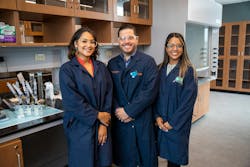NASA backs expansion for academic tech research
WASHINGTON - The National Aeronautics and Space Administration (NASA) announced the agency is awarding approximately $45 million to 21 higher-education institutions to help build capacity for research. The awards were made possible through the Minority University Research and Education Project Institutional Research Opportunity (MIRO) and Established Program to Stimulate Competitive Research (EPSCoR) grants, which are funded by the agency’s Office of Science, Technology, Engineering, and Mathematics (STEM) Engagement.
The Established Program to Stimulate Competitive Research (EPSCoR) award is directed at those jurisdictions that have traditionally not participated in competitive aerospace and aerospace-related research activities.
NASA will award 14 institutions up to $750,000 each over the course of a three-year period of performance. The awarded institutions and their projects are:
University of Mississippi in University – Development of a Lagrangian Stability Analysis Framework for High-Speed Boundary Layers
University of Alabama in Huntsville – Testing the functionality and performance of a large area detector for STROBE-X
Louisiana State University in Baton Rouge – Colloidal Assembly: Understanding the Electric Field Driven Assembly of Colloids and its Applications (Science Mission Directorate)
West Virginia University in Morgantown – Science Mission Directorate: Bringing Gravitational-Wave Astronomy into the Space Age: Next-Generation Waveform Modeling of Black-Hole Binary Coalescences for Laser Intererometer Space Antenna Data Analysis
University of Puerto Rico in San Juan – NASA EPSCoR: Space Technology Mission Directorate/Jet Propulsion Laboratory: Advancing High-Energy, Cycle-Stable Sulfur-Based Batteries for NASA Space Missions: An Integrated Framework of Density Functional Theory, Machine Learning, and Materials Innovation
Desert Research Institute, Reno, Nevada – NASA’s Ames Research Center in Silicon Valley, California: Prospecting and Pre-Colonization of the Moon and Mars using Autonomous Robots with Human-In-The-Loop
Oklahoma State University in Stillwater – A.7.4.2 Biosignature Detection of Solar System Ocean Worlds using Science-Guided Machine Learning
Iowa State University in Ames – Johnson Space Center, Ames Research Center: Non-GPS Navigation System Using Dual Star/Planetary Cameras for Lunar and Deep-Space CubeSat Missions
University of Alaska Fairbanks in Fairbanks – NASA’s Glenn Research Center in Cleveland: The Alaska – Venus analog: synthesizing seismic ground motion and wind noise in extreme environments
University of the Virgin Islands in Charlotte Amalie – University of the Virgin Islands Etelman Observatory in the Era of Time Domain and MultiMessenger Astronomy: Preparing for a New Era of Science Productivity
University of Hawaii at Manoa in Honolulu – Cubesats for Climate Change Detection of Transient Greenhouse Gas Emissions
University of Idaho in Moscow – Science Mission Directorate and Goddard Space Flight Center: Improving Global Dryland Streamflow Modeling by Better Characterizing Vegetation Use of Deep-Water Resources Using NASA’s Gravity Recovery and Climate Experiment/Gravity Recovery and Climate Experiment Follow-On, SWOT, and Land Information System
University of Arkansas in Little Rock – AR- III-Nitride Ultraviolet Laser Diodes for Harsh Environments, Space Based Communications, and Remote Sensing (Space Technology Mission Directorate)
South Dakota School of Mines and Technology in Rapid City – Science Mission Directorate: High Spatial-Temporal Resolution Soil Moisture Retrieval using Deep Learning Fusion of Multimodal Satellite Datastreams.
NASA is also providing seven minority-serving institutions will receive approximately $5 million each over a five-year period of performance for projects that span a variety of research topics as part of the Minority University Research and Education Project Institutional Research Opportunity (MIRO) Awards. The institutions and their proposed projects are:
Alaska Pacific University in Anchorage – Alaska Pacific University Microplastics Research and Education Center
California State University in Fullerton – SpaceIgnite Center for Advanced Research-Education in Combustion
City University of New York, Hunter College in New York – NASA-Hunter College Center for Advanced Energy Storage for Space
Florida Agricultural and Mechanical University in Tallahassee – Integrative Space Additive Manufacturing: Opportunities for Workforce-Development in NASA Related Materials Research and Education
New Jersey Institute of Technology in Newark – AI Powered Solar Eruption Center of Excellence in Research and Education
University of Houston in Houston – NASA MIRO Inflatable Deployable Environment and Adaptive Space Systems Center
University of Illinois in Chicago – Center for In-Space Manufacturing: Recycling and Regolith Processing.
Both awards were made through NASA’s Office of STEM engagement solicitations. They promote STEM literacy to enhance and sustain the capability of institutions to perform NASA-related research and education, which directly supports the agency’s mission directorates.
